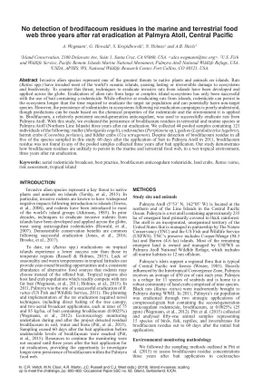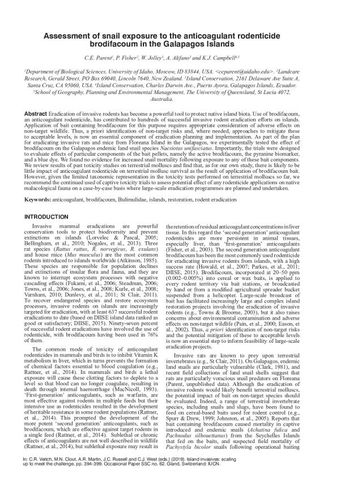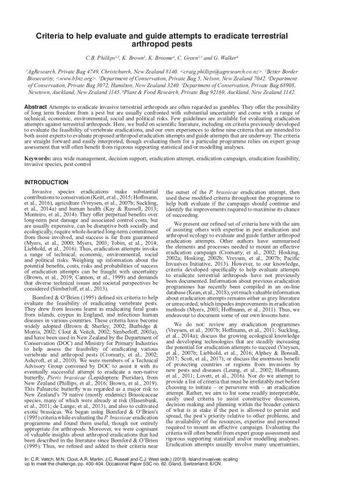No detection of brodifacoum residues in the marine and terrestrial food web three years after rat eradication at Palmyra Atoll, Central Pacific
- Description:
- Invasive alien species represent one of the greatest threats to native plants and animals on islands. Rats (Rattus spp.) have invaded most of the worlds oceanic islands, causing lasting or irreversible damage to ecosystems and biodiversity. To counter this threat, techniques to eradicate invasive rats from islands have been developed and applied across the globe. Eradication of alien rats from large or complex island ecosystems has only been successful with the use of bait containing a rodenticide. While effective at eradicating rats from islands, rodenticide can persist in the ecosystem longer than the time required to eradicate the target rat population and can potentially harm non-target species. However, the persistence of rodenticides in ecosystems following rat eradication campaigns is poorly understood, though predictions can be made based on the chemical properties of the rodenticide and the environment it is applied in. Brodifacoum, a relatively persistent second-generation anticoagulant, was used to successfully eradicate rats from Palmyra Atoll. With this study, we evaluated the persistence of brodifacoum residues in terrestrial and marine species at Palmyra Atoll (Northern Line Islands) three years after rat eradication. We collected 44 pooled samples containing 121 individuals of the following: mullet (Moolgarda engeli), cockroaches (Periplaneta sp.), geckos (Lepidodactylus lugubris), hermit crabs (Coenobita perlatus), and fiddler crabs (Uca tetragonon). Despite detection of brodifacoum residue in all five of the species sampled in this study 60 days after the application of bait to Palmyra Atoll in 2011, brodifacoum residue was not found in any of the pooled samples collected three years after bait application. Our study demonstrates how brodifacoum residues are unlikely to persist in the marine and terrestrial food web, in a wet tropical environment, three years after rat eradication.
- Display date:
- 2019
- Collections:
- Secretariat of the Pacific Regional Environment Programme (SPREP)
- Publisher:
- International Union for Nature Conservation (IUCN)
- Content partner:
- Secretariat of the Pacific Regional Environment Programme (SPREP)
- Availability:
- Not specified
-
Copyright status: All rights reservedFind out more about what you are able to do with this itemThis item is all rights reserved, with means you'll have to get permission from Secretariat of the Pacific Regional Environment Programme (SPREP) before using it. For more information, please see our use and reuse page.What can I do with this item?Non-infringing useNZ copyright law does not prevent every use of a copyright work, and this item may be hosted by an international institute or organisation. You should consider what you can and cannot do with a copyright work.No sharingYou may not copy and/or share this item with others without further permission. This includes posting it on your blog, using it in a presentation, or any other public use.No modifyingYou are not allowed to adapt or remix this item into any other works.No commercial useYou may not use this item commercially.
Related items
Welcome and warm Pasifik greetings
The information on this site has been gathered from our content partners.
The names, terms, and labels that we present on the site may contain images or voices of deceased persons and may also reflect the bias, norms, and perspective of the period of time in which they were created. We accept that these may not be appropriate today.
If you have any concerns or questions about an item, please contact us.


